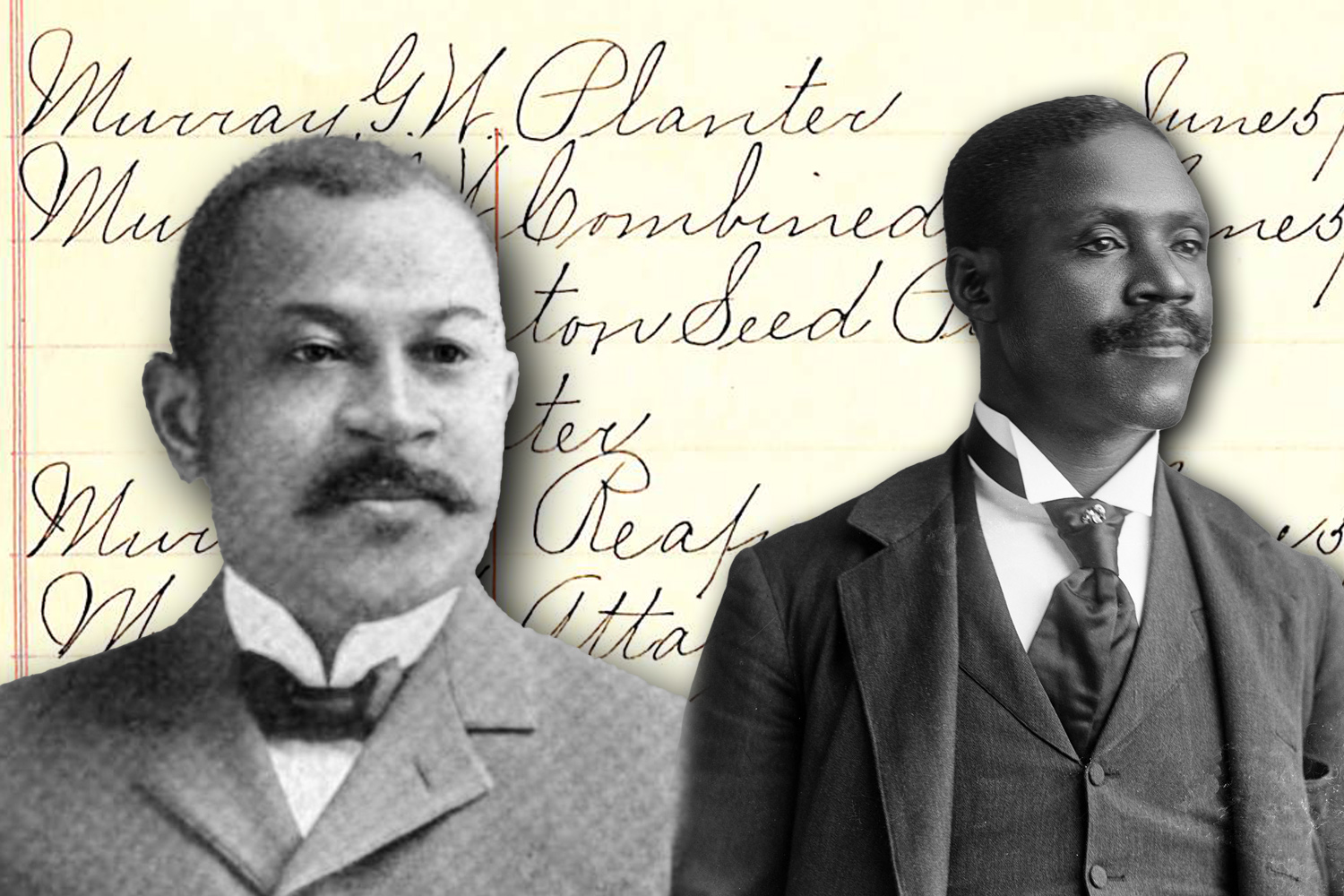
Found on Baker’s list
In 1894, U.S. Representative George Washington Murray read a list of African American patent holders into the Congressional Record. Murray himself was on the list, which was compiled by patent examiner and civil rights activist Henry Baker. Their lives, connected by the list, tell a story of public service, activism through invention, and how innovative minds can build a better and more just world.
16 min read
Each month, our Journeys of Innovation series tells the stories of inventors or entrepreneurs who have made a positive difference in the world. This month’s story, which marks the 50th original Journeys of Innovation, is dedicated to the work of civil rights activist and patent examiner Henry Baker and African American inventors whose work he chronicled throughout his life.
Do you know an innovator or entrepreneur with an interesting story?
3,973 – Joseph Hawkins, West Windsor, N.J. March 26, 1845. Improved Gridiron.
61,941 – Henry Lee, Richmond, Va., February 12, 1867. Animal Trap.
64,205 – W.A. Dietz, Albany, NY. April 30, 1867. Shoe.
On August 10, 1894, U.S. Representative George Washington Murray, an inventor himself, read a list of 92 inventions patented by African Americans on the floor of the House of Representatives. Ranging from improvements for steam engines to dough kneaders, from telephone transmitters to game tables, this list of inventions reflected the needs of a society that was industrializing and commercializing at a rapid rate. Each entry also represented the story of an inventor who overcame obstacles, received a patent, and, in some cases, saw their invention commercialized and put to use.
Murray, the only Black member of Congress at the time, stated that African Americans had “proven in almost every line that we are...capable of making almost anything that other people can make or have made.” The proof was in his hand.
The list itself was the work of Henry Edwin Baker, a lawyer and assistant patent examiner who had compiled the first roster of African American patent holders throughout U.S. history. Over the next few decades, Baker’s list would grow to several hundred entries, an immense repository of contributions by Black inventors to the technological progress of humanity and a powerful record of the public quest for racial equality at the turn of the 20th century.
Henry Baker and George Washington Murray were connected by much more than just this list. Contemporaries in era and ethos, they shared (at times) a city of residence, a dedication to public service, and an enduring legacy in the struggle for civil rights.
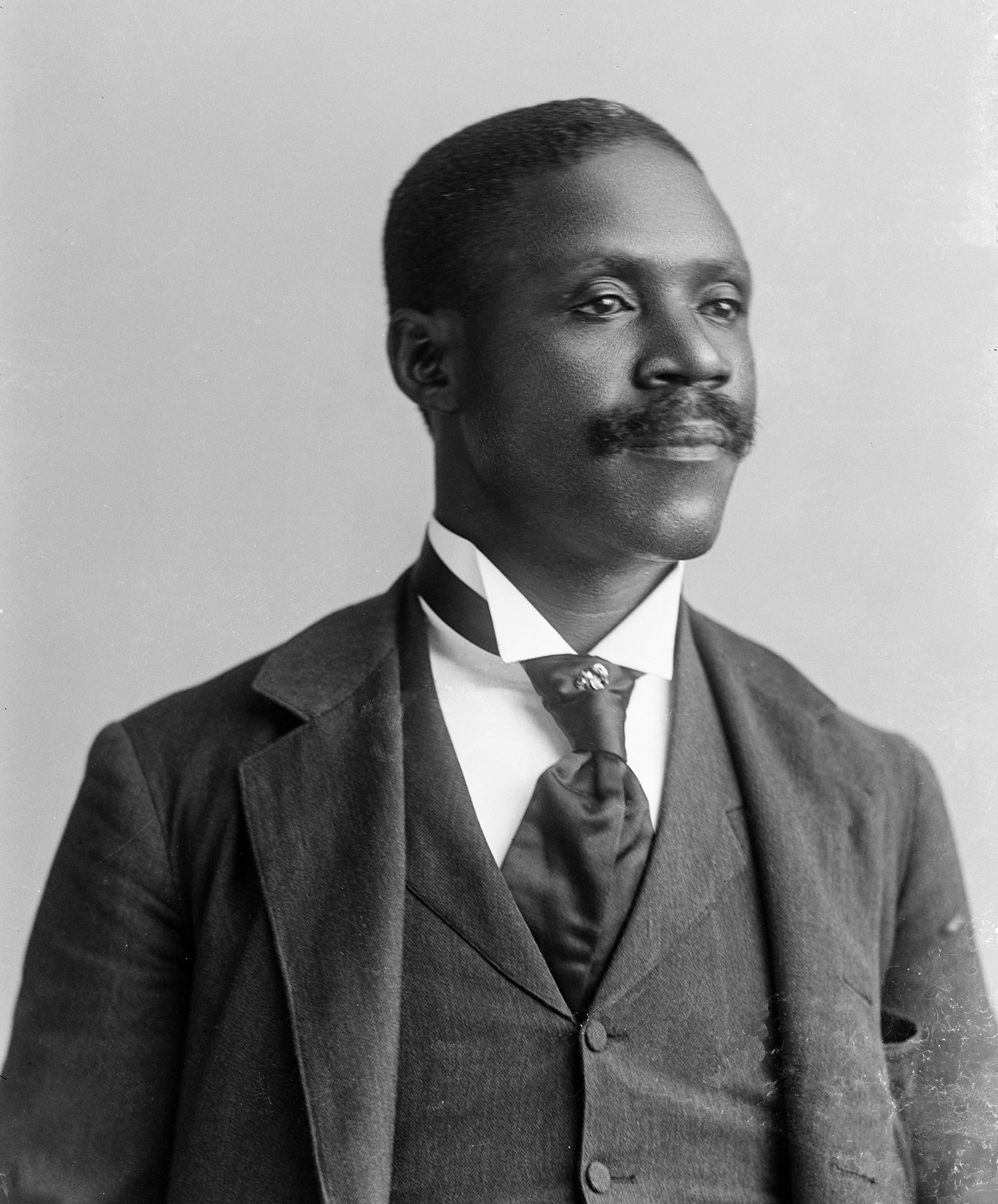
George Washington Murray became a community leader through agriculture and a national figure through politics. His patented inventions connect to both. (Courtesy of the Library of Congress)
Growing up during the Reconstruction Era, at a time when African Americans worked hard to claim the rights of citizenship and made significant gains towards economic and educational equality, George Washington Murray became a leader in education, agriculture, and politics. Born in Sumter County, South Carolina in 1853, he began his life enslaved. By 1865, Murray was free, but also orphaned, and he received little formal education during his childhood. He likely taught himself to read and write, and he found employment as both a farmer of a small parcel of land and as a teacher at a local school by 1871.
Murray would teach his classes during the day while farming in the mornings and evenings, showing a clear determination to better his station from an early age. He began studies at the recently integrated University of South Carolina in 1874, but he was forced to withdraw from the university only three years later in 1877, when federal troops were pulled out of the South as part of the political bargain to end Reconstruction. As a result, white terrorist organizations like the Ku Klux Klan forced schools like the University of South Carolina to expel Black students.
Murray eventually finished his degree at a nearby Normal School, an institution created to train teachers, and settled into life as a farmer in Sumter County with his wife, Ella. He built a successful agricultural operation that included corn, cotton, livestock, and selling wood. Profits from his 64-acre farm enabled him to hire a farm hand, a measure of success for any independent farmer at the time. In the early 1880s, Murray became frustrated when several of his farm implements broke down in a single day. His wife’s sewing machine with interchangeable attachments gave him an idea for a similar mechanism for farming.
For the next decade, he worked on perfecting his invention, applying for eight patents in 1893. Despite having eight different numbers and titles, Murray’s patents were for different attachments for the same machine, allowing a farmer to cultivate, plant, fertilize, reap, and chop up different crops with ease. In the patents, Murray described his inventions as “cheap,” “simple,” and “durable,” and explained that they could be useful in farming grain, cotton, corn, peas, and other crops. In the late 19th century, this type of versatile and accessible equipment would have been appealing to African American farmers seeking to make a living off a relatively small plot of land with little to no inherited equipment.
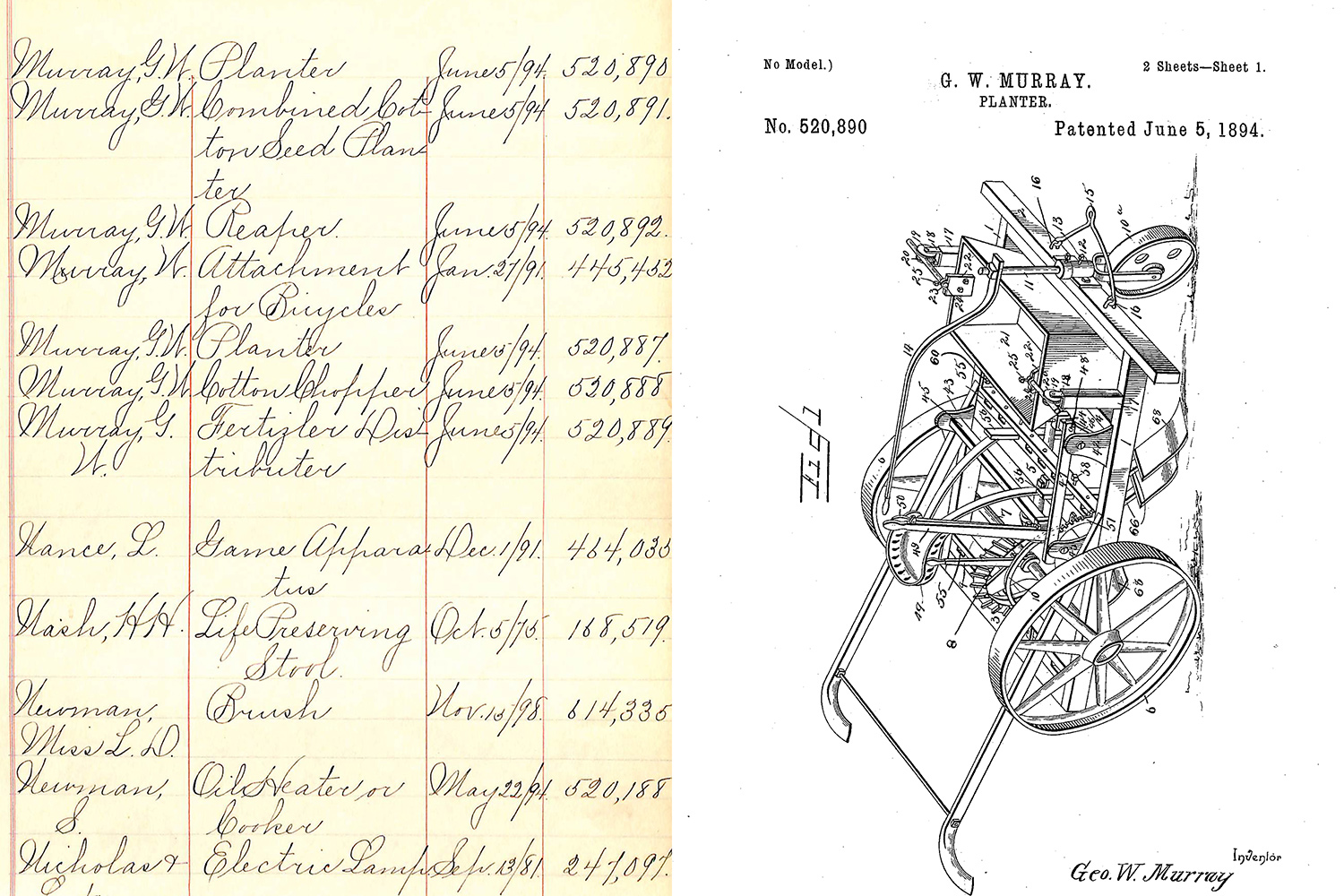
In a handwritten version of Henry Baker’s list from 1899, six of Murray’s patents are listed, including U.S. Patent No. 520,890 for a planter. Baker continued to add to and refine the accuracy of his list throughout his lifetime.
Murray’s inventions did not revolutionize agriculture. Although his mechanisms were unique, many farmer-inventors had similar ideas for interchangeable parts in an era where the benefits of such technology were increasingly apparent in various areas of manufacturing. Like many patented inventions then and now, Murray’s were incremental improvements over existing technology. But the story surrounding his inventions – the decade spent developing them, the versatility, the desire to apply for a patent – reveals a man looking to not only raise his own station, but the station of others in his community.
For Murray, farming was also a gateway into politics.
In 1880, he was selected as a delegate to South Carolina’s Republican Party convention, and he became more heavily involved over the next decade. After being appointed as the customs inspector to the Port of Charleston in 1890, he decided to run for Congress, following in the footsteps of other Black politicians who served his district in the decades following the Civil War. Murray lost the 1890 election but was undeterred. He ran again in 1892 and was elected despite attempts to suppress votes in the 75% majority Black district, which included parts of the City of Charleston and the South Carolina coastline.
While Murray was beginning his political career in Washington, Henry Baker was well underway on the project that would become his legacy – documenting Black innovators who received patents. Like Murray, he faced significant barriers to success based on his race and, in many cases, overcame them.
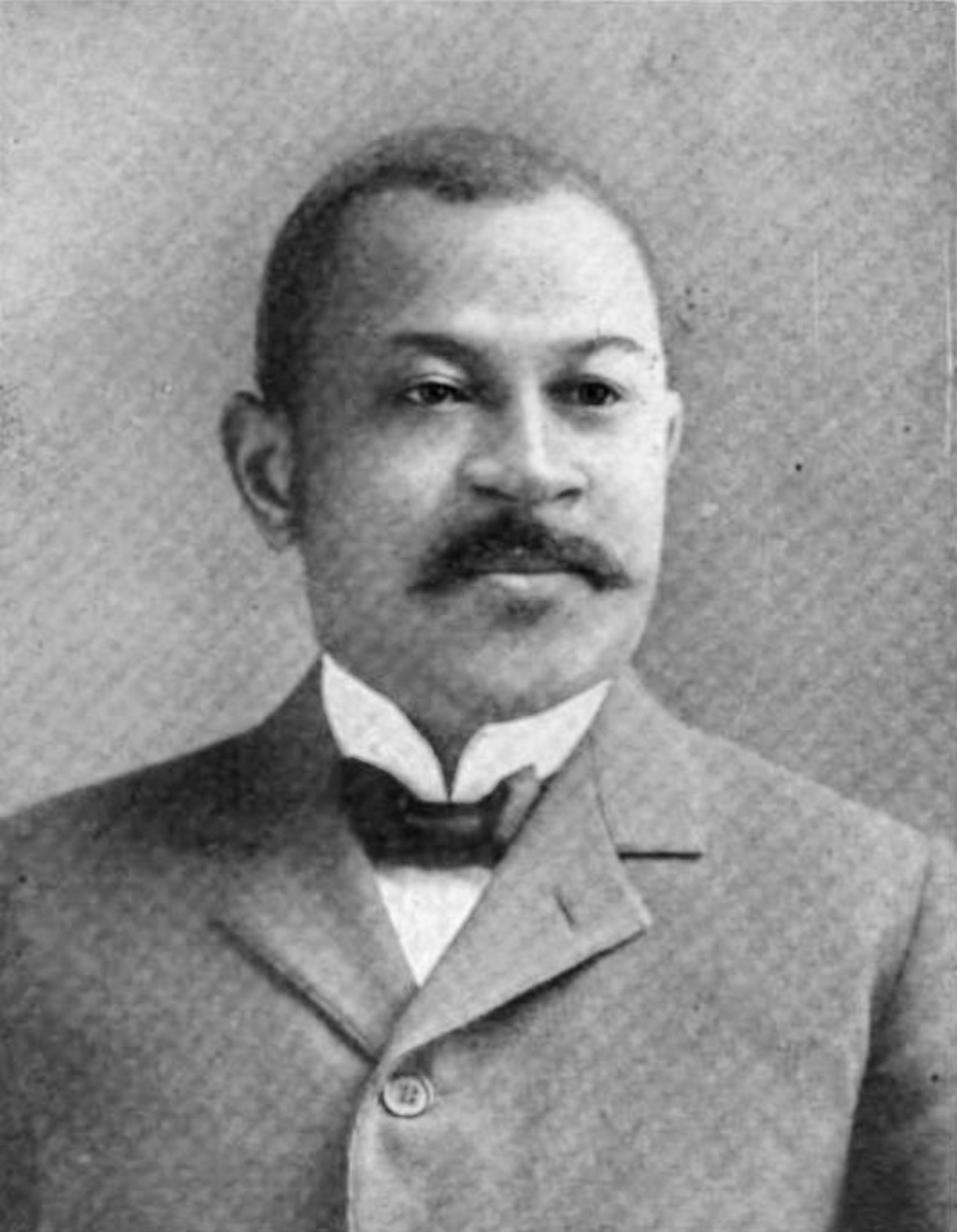
Henry Baker’s list of African American inventors remains the foundation of much of what we know about Black innovation in early U.S. history.
Baker was born in Columbus, Mississippi around 1857, a few years after Murray and a few years before the outbreak of the American Civil War. The details of his early life, including whether he was free or enslaved, are scarce. Despite this dearth of information, Baker’s actions during his early years suggest he was academically gifted, hard-working, and determined.
In 1874, Baker became the third African American midshipman to enter the U.S. Naval Academy at Annapolis, Maryland. Subject to intense harassment and racial persecution, he left the Academy before graduating and was the last African American student enrolled there until 1936. He then moved to Washington, D.C., where he earned a law degree from Howard University. While finishing his degree, Baker began his career at the Patent Office as a copyist. He eventually rose to the position of second assistant examiner.
In addition to the responsibilities of his full-time job, Baker took on a workload likely equivalent to another full-time job, early in his career – chronicling the inventions of African Americans.
The rapid rate of innovation in the latter half of the 19th century popularized large exhibitions where members of the public could marvel at the latest technologies and improvements. African American activists seized these demonstrations as opportunities to highlight the ingenuity of Black innovators. It was in support of these endeavors that Baker began compiling his list.
Making the list wasn’t easy. The Patent Office did not (and the USPTO still does not) collect demographic data. How do you research a topic—the races of patented inventors—for which no official record exists? Baker described the difficulty of his research in a 1916 letter:
“I have been endeavoring for several years past to collect as complete a list as is possible of all the United States patents granted to Negroes for their inventions, and while my position as an Assistant Examiner in this office has given me full access to the complete Office records, I have found it practically impossible to make much headway in my understanding when relying solely upon these records, because they do not distinguish among patentees as to race, only as to nation.”
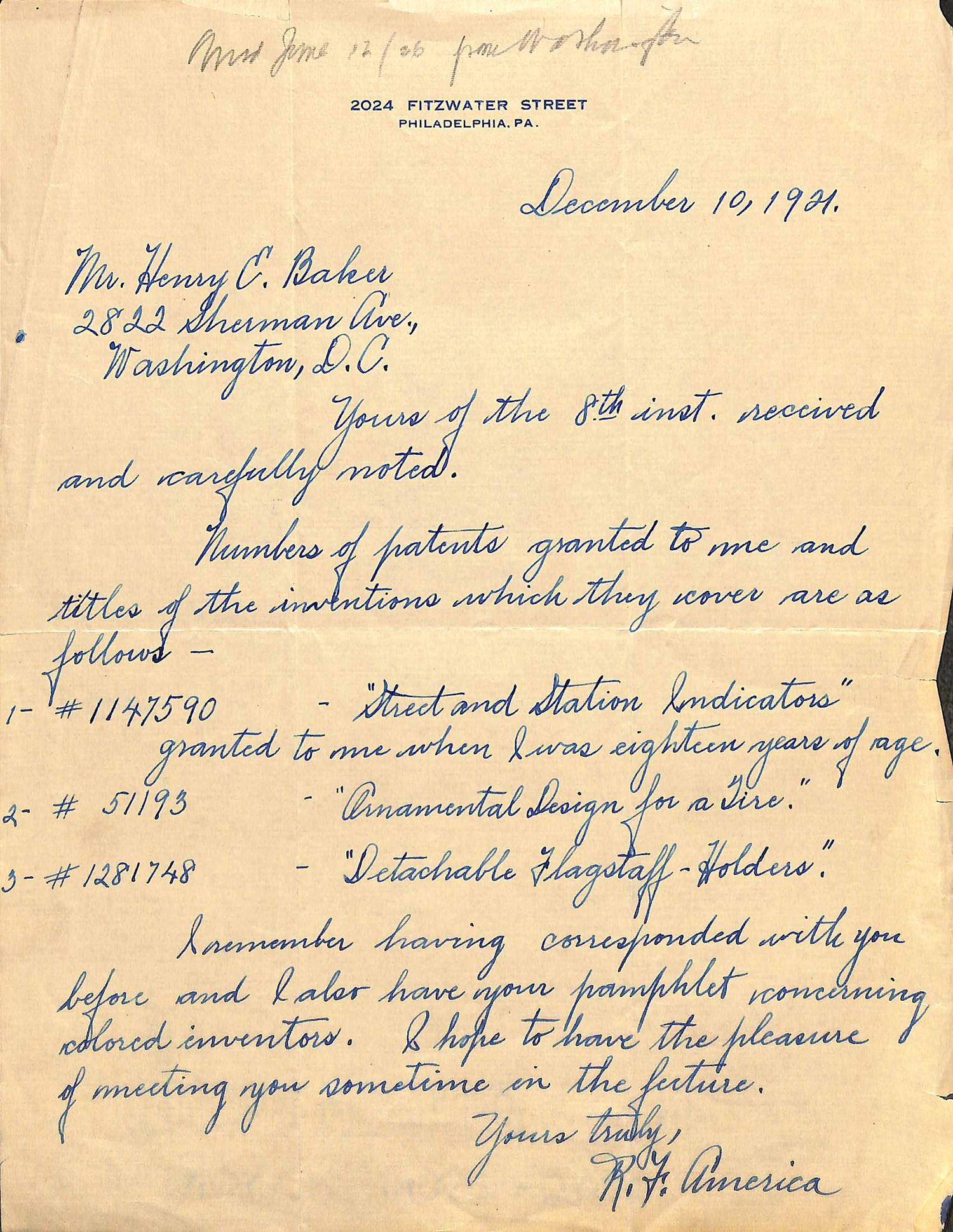
Baker’s work compiling his list started in the late 1880s and continued into the 1920s, even after his retirement from the Patent Office. This 1921 letter is from Richard F. America, one of the youngest inventors on his list. (Courtesy of the National Archives)
Baker’s solution was crowdsourcing. He queried formal and informal networks of examiners, attorneys, businesspeople, and community leaders to locate African American patent owners and chronicle their innovations. He sent letter after letter, with return postage included, asking the recipients of his correspondence to send back any information they had on Black inventors. By 1913, he estimated that he reached nearly two-thirds of the 12,000 registered patent attorneys in the country at the time.
Many of those who Baker contacted never responded. Some replied politely that they had not come across any Black patent holders in their work but were interested in learning more about Baker’s research. But Baker also received some overtly negative replies. One lawyer from Tennessee even wrote that he was “inclined to regard the whole subject as a joke.” This attitude highlighted the very necessity of Baker’s work – proof of African American innovation would delegitimize the stereotype that it was not possible.
Some African American inventors did not receive patents due to structural and financial barriers. “I have not actually known of any colored inventors obtaining patents, but have known several who were good machinists, engineers and other mechanics, and whom have made actual improvements,” wrote a Mr. Frank R. Williams in reply to Baker. Baker speculates that other inventors chose not to reveal their race, fearing it would harm the commercial value of their invention, prompting Baker to write that “in view of the prevailing sentiment in many sections of our country, it cannot be denied that much reason lies at the bottom of such conclusion.” The young patent examiner faced an uphill battle.
But he received enough leads and positive replies to begin compiling his list. By 1886, Baker had found 45 patents granted to people known to have been African American.
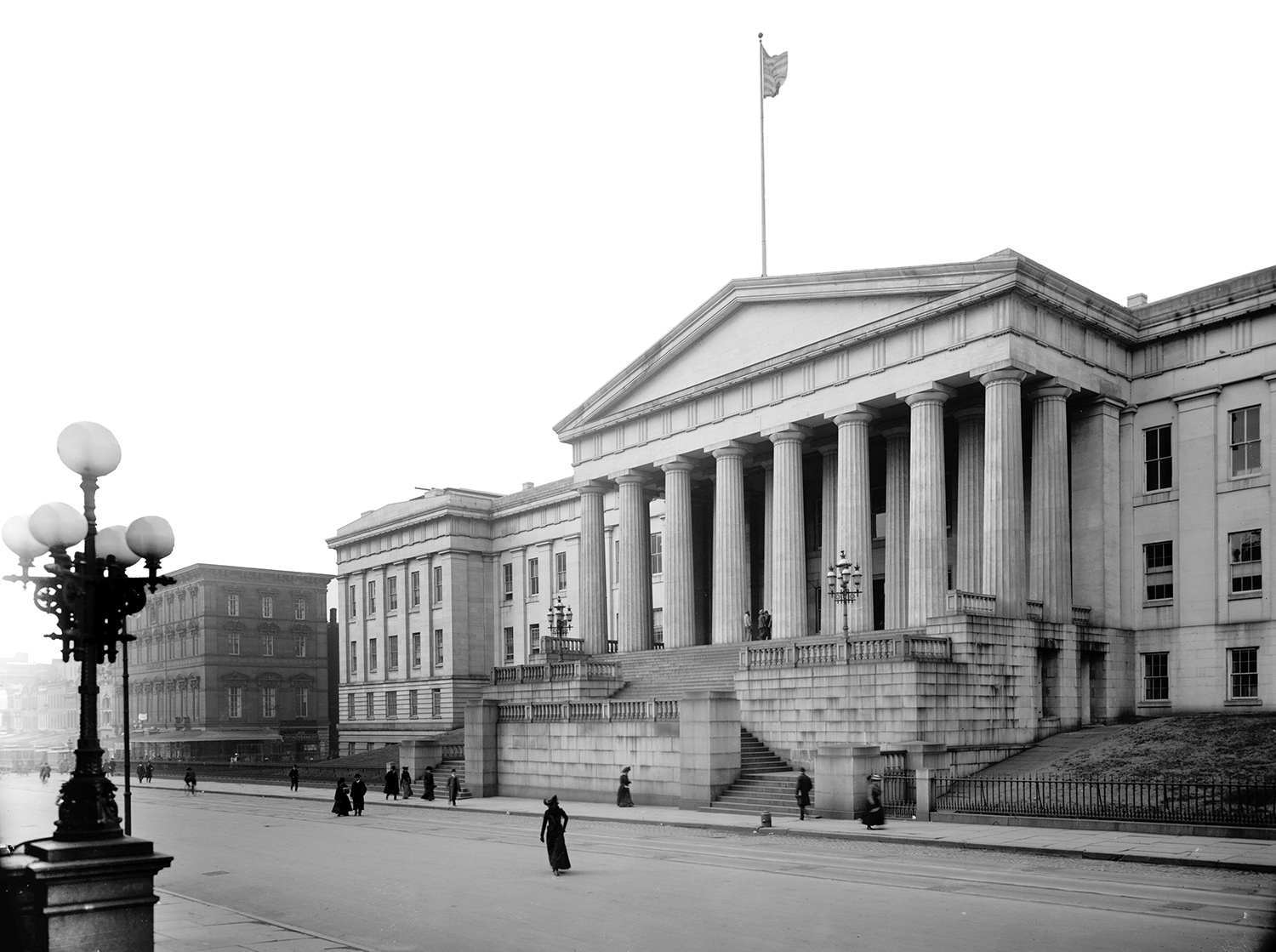
At the time of Henry Baker’s employment, the Patent Office was located in downtown Washington, D.C., in the building that now houses the National Portrait Gallery and Smithsonian American Art Museum. The word “Trademark” was added to the agency’s title in 1975. (Courtesy of the Library of Congress)
Baker also leveraged his networks as a prominent member of the African American community in Washington, D.C. to find more connections. His residence in the early 20th century, 2822 Sherman Avenue, lay in the heart of a middle-class, largely African American neighborhood housing professionals, business owners, office workers, government employees, and professors and staff of nearby Howard University. Handsome rowhouses lined side streets and the north-south thoroughfares. From there, Baker could have walked or taken the streetcar down Georgia Avenue to work at the Patent Office in the city’s central business district. He was involved in his church, civil rights work, and organizations like the Bethel Literary and Historical Association, where he served with two of the patented inventors on his list.
Baker likely connected with George Washington Murray through one or more of these groups. In the summer session of Congress in 1894 where he read Baker’s list aloud, Murray’s name was already documented alongside the other African American inventors for the patents he received just months before. He was advocating for legislation to fund another great exhibition – and another opportunity for African American innovators to showcase the physical proof of their contributions to American society. His goal was to secure Congressional approval for the Cotton States Exhibition, an effort to highlight Southern economic and technological development in the decades following the Civil War. Gripping the list, Murray, who was given the moniker the ‘Republican Black Eagle’ for his oratorical skills, said:
“Mr. Speaker, the colored people of this country want an opportunity to show that the progress that the civilization which is now admired the world over, that the civilization which is now leading the world, that the civilization which all nations of the world look up to and imitate – the colored people, I say, want an opportunity to show that they, too, are part and parcel of that great civilization."
386,289 – Miss M.E. Benjamin, Washington, D.C., July 17, 1888. Gong and Signal Chair for Hotels.
391,577 – A.B. Blackburn, Springfield, Ohio, October 23, 1888. Cash Carrier.
392,908 – J.S. Coolidge, Washington, D.C., November 13, 1888. Instantaneous Detachment for Horses.
Murray’s bid for legislation was unsuccessful, but he entered the names of these inventors into the Congressional Record forever.
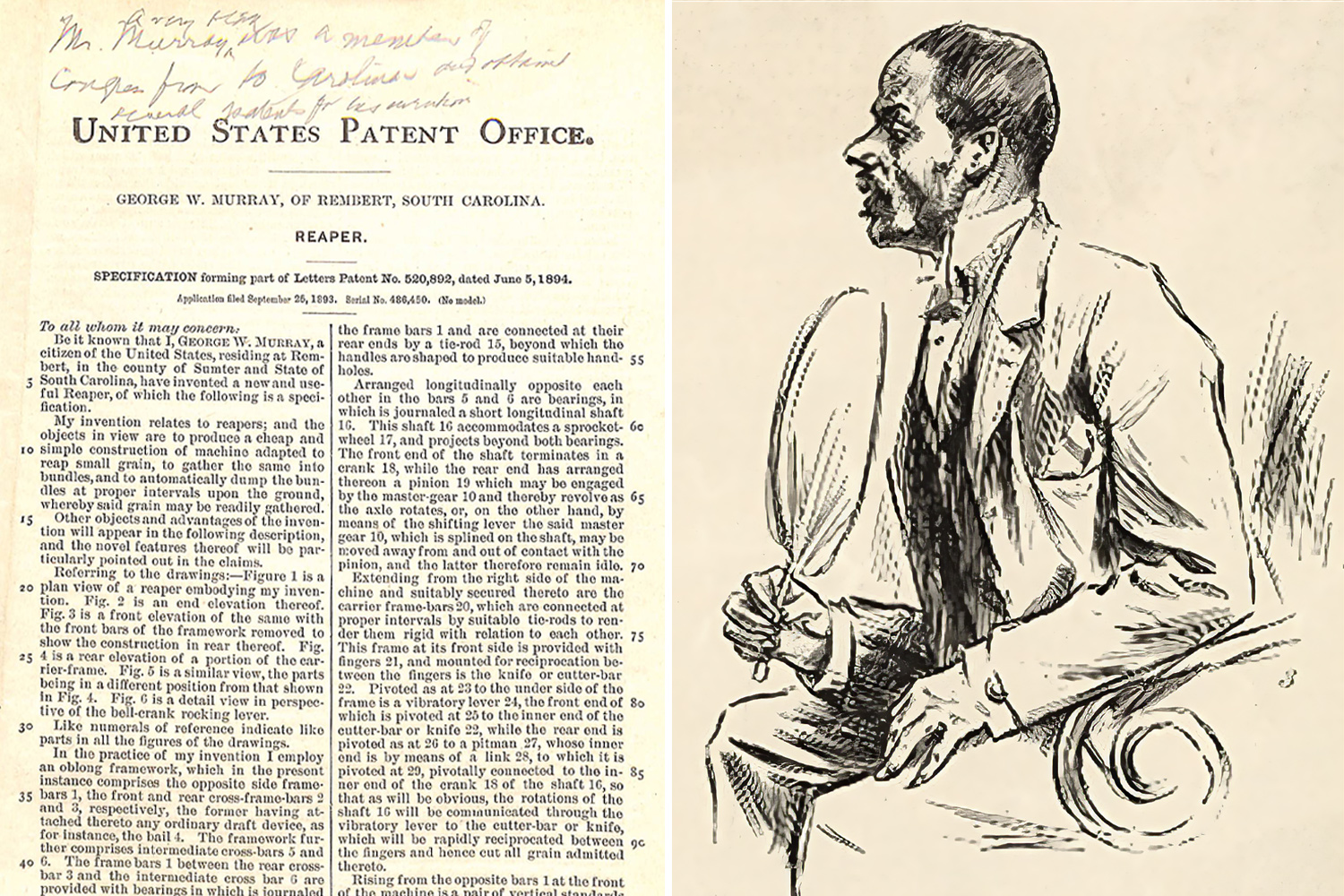
At left is a copy of Murray’s U.S. Patent No. 520,892 for a reaper: in the top margin, Baker scrawled, “Mr. Murray was a member of Congress from So. Carolina and obtained several patents for his inventions.” At right is an 1893 sketch of Murray on the floor of the House of Representatives during the 53rd Congress. (Courtesy of the House of Representatives)
With racial violence and voter suppression on the rise, many of Murray’s voters were harshly disenfranchised, and he lost his bid for re-election in 1896. He was the last Black congressional representative from South Carolina for nearly a century.
Murray turned his attention towards bringing his patented inventions to market, entering into a partnership with a Black lawyer named J. Milton Turner. Murray and Turner opened a manufacturing shop in St. Louis in 1897, planning to develop a prototype for field testing. The partnership fell apart the following year, and Murray’s invention never went into production. He returned to his farm, investing in land and leasing that land out to Black farmers. His success in politics and farming, as well as his work to help others achieve financial independence, made him a target.
In 1903, Murray was charged with the crime of forging names on a lease agreement. His biographer John F. Marszalek cites this as an example of “white capping,” or retaliation against a successful Black person with unjust and sometimes violent means. Convicted by an all-white jury, Murray was sentenced to three years in a chain gang or state penitentiary. He fled to Chicago to avoid this sentence, leaving behind his wife, his farm, and the county he’d called home for most of his life. Although he attempted to enter politics in his new city, Murray would never hold office again.
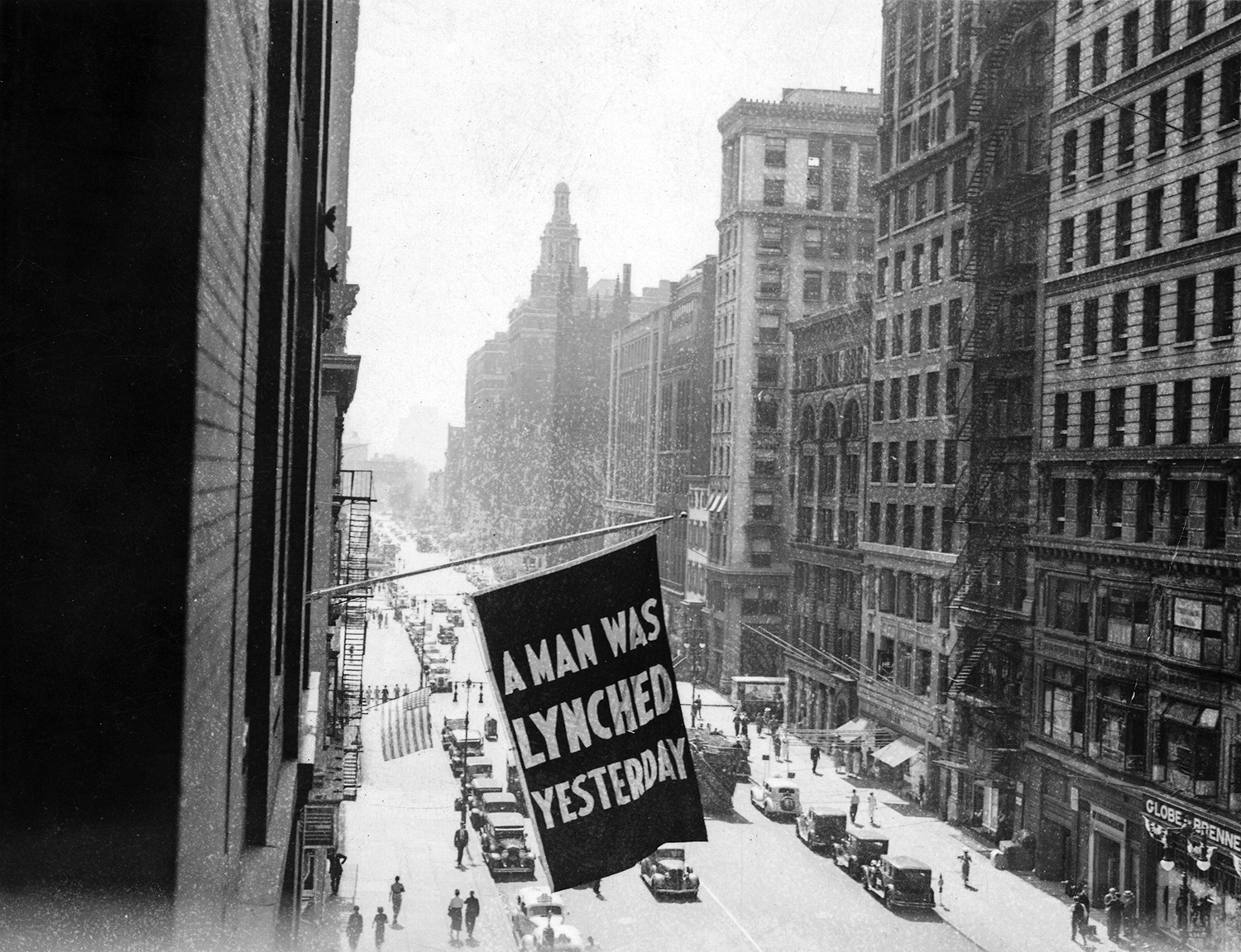
This flag, flown from the National Association for the Advancement of Colored People (NAACP) headquarters in New York City, was a visceral reminder of the racial oppression, segregation, and widespread violence African Americans faced in the early 20th century. Successful professionals and civil rights activists like Murray and Baker were risking their lives. (Courtesy of the Library of Congress)
While Murray’s career in politics was ending, Henry Baker’s career at the Patent Office was stagnating. While he had developed a very good reputation at the office, and by 1902 had been promoted to second assistant examiner, he would not advance beyond this level professionally at a time of increasing segregation and racial discrimination in the federal government.
His work on his list continued nevertheless. By the end of the 19th century, the Patent Office was supportive of Baker’s work, and he was even directed by the Commissioner of Patents at the time to compile his list for civil rights activist W.E.B. DuBois’ “Negro Exhibit” at the 1900 Paris Exposition. This version of the list grew to around 370 names.
Towards the end of his career at the Patent Office, the Commissioner of Patents was supplying his own official letterhead for Baker to use when he made inquiries of inventors and patent attorneys. Although he conducted much of this work on his own, the Patent Office did recognize Baker’s contributions in 1913 by sending him on an official detail to “arrange an exhibit in relation to patents at the Emancipation Exposition” in New York.
Also in 1913, Baker’s essay “The Colored Inventor: A Record of Fifty Years” was published in The Crisis, the main periodical of the NAACP. In this essay, Baker claimed to have identified and confirmed 800 patents belonging to Black inventors. He also expressed hope that his research would change minds about the innovative capabilities of African Americans, opening doors so that the next generation of inventors could be proud of their race as well as their creations. In his conclusion, he wrote:
“We can never know the whole story. But we know enough to feel sure that if others knew the story even as we ourselves know it, it would present us in a somewhat different light to the judgment of our fellow men… so that some one[sic] in the distant future, looking down the rugged pathway of the years, may see this race of ours coming up, step by step, into the fullest possession of our industrial, economic, and intellectual emancipation.”
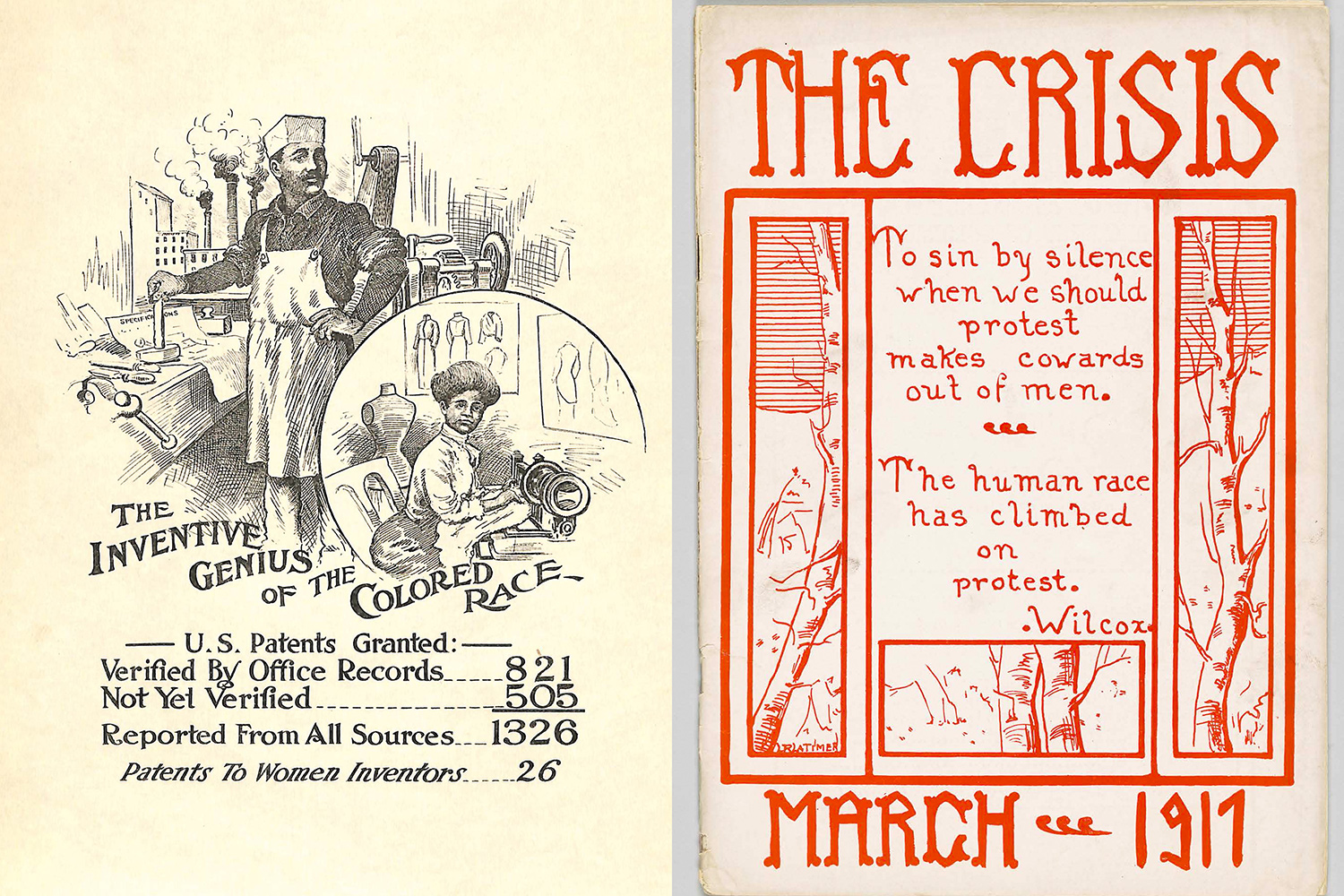
This sketch depicting African American inventors in the fields of carpentry and textiles was found amongst Baker’s papers in the National Archives. It seems to relate to his 1913 article in The Crisis, a publication created by civil rights activist and historian W.E.B. Du Bois. (Left image courtesy of the National Archives and Records Administration. Right image courtesy of the National Museum of African American History and Culture.)
Baker’s efforts to find and publicize records of African American inventiveness were attempts to counter the intensifying racism of his day. His research and record-keeping were part of a growing civil rights movement, and his work had lasting significance far beyond his lifetime.
Henry Baker died in Washington, D.C. in 1928, two years after George Washington Murray was buried in an unmarked grave in a Black cemetery on the outskirts of Chicago.
Today, Murray is recognized as one of the leading Black politicians of the 19th century and a trailblazing advocate for voting rights and economic advancement for African Americans in the South. Henry Baker is not as well known, but many of the inventors on his list appear in history books, prior art searches, and even in the National Inventors Hall of Fame. Their stories also appear in family histories, community remembrances, and, very likely, in archives waiting to be uncovered. Baker’s list, printed countless times in the 20th century, became a powerful corrective to the racist aspersion that African Americans were incapable of innovation. Here was hard evidence of a long line of inventions deemed worthy of patenting by examiner-experts in the employ of the U.S. government.
The exceptional inventors found on the list, some famous and some lesser known, continue to inspire. It is our privilege to tell their stories, as well as the story of the man who ensured they would not be forgotten.
450,550 – W.B. Abrams, Wells, N.Y., April 14, 1891. Hame Attachment.
451,086 – George Toliver, Philadelphia, Pa., April 28, 1891. Propeller for Vessels.
520,890 – G.W. Murray, Rembert, S.C., June 5, 1894. Planter.
On February 24, as part of our Black Innovation & Entrepreneurship series, we will be honoring Henry Baker and the inventors on his list with the premiere of America’s Ingenuity, a documentary short focusing on the story of Richard F. America, one of the youngest inventors on Baker’s list who held three patents. The documentary, created in partnership with the National Inventors Hall of Fame, features an interview with his son, the only known living child of an inventor on Baker’s list.
Do you know of an inventor who should be included on Baker’s list, or want to collaborate with us on getting the word out? Email historian@USPTO.gov for more information.
Credits
Produced by the USPTO’s Office of the Chief Communications Officer. For feedback or questions, please contact inventorstories@uspto.gov.
Story by Rebekah Oakes, with contributions from Adam Bisno. Special thanks to Richard F. America, Jr., the National Archives and Records Administration, and the National Inventors Hall of Fame.
References
Baker, Henry E. The Colored Inventor: A Record of Fifty Years. Project Gutenberg, 2007.
Baker, H.E. “The Negro as an Inventor,” in Twentieth Century Negro Literature; or, A Cyclopedia of Thought on the Vital Topics Relating to the American Negro, ed. Daniel Wallace Culp, 398–413 (Toronto: J.L. Nichols, 1902), unnumbered leaf after p. 398.
Department of the Interior: Patent Office. Records Relating to Colored Inventors, 1899-1921. National Archives and Records Administration, College Park, MD.
Fouché, Rayvon. Black Inventors in the Age of Segregation: Granville T. Woods, Lewis H. Latimer, and Shelby Davidson. Baltimore: Johns Hopkins University Press, 2004.
Hintz, Eric S. American Independent Inventors in an Era of Corporate R&D. Cambridge: The MIT Press, 2021.
Marszalek, John F. A Black Congressman in the Age of Jim Crow: South Carolina’s George Washington Murray. Gainesville: University Press of Florida, 2006.
“Murray, George Washington.” History, Art, & Archives: United States House of Representatives. December 28, 2022. https://history.house.gov/People/Detail/18709
Sluby, Patricia Carter. The Inventive Spirit of African Americans. Westport: Praegar, 2004.
Swanson, Kara W. “Race and Selective Legal Memory: Reflections on ‘Invention of a Slave.’” Columbia Law Review 120 (2020): 1077–1118.



